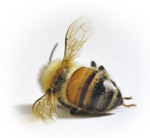12
May
Pesticides, Not Mites or Pathogens, Major Cause of Honey Bee Decline
(Beyond Pesticides, May 12, 2014) A study published in the Bulletin of Insectology substantially undercuts chemical industry arguments that neonicotinoid pesticides are not the primary contributing factor in Colony Collapse Disorder (CCD). The results find that hives exposed to low doses of two neonicotinoid pesticides””imidacloprid and clothianidin””do not recover from over winter losses from which control hives quickly rebound. Researchers also discount other possible causes of CCD commonly touted by industry like diet, parasites, and pathogens. The study adds to the already expansive literature that clearly links sublethal exposure neonicotinoid pesticides to rapid bee declines nationwide.
Colony Collapse Disorder (CCD). The results find that hives exposed to low doses of two neonicotinoid pesticides””imidacloprid and clothianidin””do not recover from over winter losses from which control hives quickly rebound. Researchers also discount other possible causes of CCD commonly touted by industry like diet, parasites, and pathogens. The study adds to the already expansive literature that clearly links sublethal exposure neonicotinoid pesticides to rapid bee declines nationwide.
The study, Sub-lethal exposure to neonicotinoids impaired honey bees winterization before proceeding to colony collapse disorder, was conducted in central Massachusetts during the 2012-2013 winter at three different locations with six bee colonies in each location. A third of the colonies were exposed to low doses of the pesticide imidacloprid, while another third were exposed to the pesticide clothianidin, both neonicotinoids, and the remainders were not treated. At each apiary the colonies were separated into two groups in which honey bees were fed with either sucrose water or high-fructose corn syrup (HFCS) over the study period.
During the fall and winter seasons, researchers found that honey bees declined in all 18 colonies, typical of the seasonal pattern. Come January, however, the number of treated bee colonies continued to decline while the untreated hive began to recover and the trend continued throughout the year. By April, the majority of bees in all neonicotinoid-treated colonies, regardless of whether they survived or not, had abandoned their hive during the winter ””a symptom that typifies CCD. Control hives were repopulated quickly with new emerging bees.
In their discussion, researchers indicate that the results replicate previous studies relating to imidacloprid and reinforce the conclusion that sublethal exposure to neonicotinoids is a primary cause of CCD, minimizing the role of mites and pathogens. Indeed, the study found no significant difference in the degree of Varroa mite infection between non-treated and neonicotinoid-treated colonies. Additionally, the only hive effected with Nosema ceranae, an intestinal parasite, was a control hive and that the dead bees affected with this parasite did not abandon the hive. The study highlighted:
“It is imperative to emphasize that while pathogen infections are common and serious diseases found in honey bees that often lead to colony death, the post-mortem examinations of the pathogen- caused dead colonies are vastly different to those suffered from CCD.One of the defining symptomatic observations of CCD colonies is the emptiness of hives”¦. [Thus] the absence of dead bees in the neonicotinoid-treated colonies is remarkable and consistent with CCD symptoms.”
Colony Collapse Disorder is unlike other ailments that affect honey bees because worker bees simply disappear rapidly, never returning to the hive where the queen still lives with a small cluster of bees amidst pollen and honey stores in the presence of immature bees (brood). It has been reported that losses of honey bee colonies across 21 states in the winter of 2007-8 averaged 35 percent. This past winter over winter losses in Ohio were between 50 to 80 percent.
This study adds to the growing scientific literature that shows honey bee losses due to the ubiquitous use of neonicotinoid pesticides is “No Longer a Big Mystery.” Neonicotinoids are systemic, meaning that as the plant grows the pesticide becomes incorporated into the plant. When honey bees and other pollinators forage and collect pollen or nectar, or drink from what are termed “guttation” (water) droplets emitted from neonicotinoid-incorporated crops, they are exposed to sublethal doses of the chemical. At this level, the pesticides don’t kill bees outright. Instead, they impair bees’ ability to learn, to find their way back to the hive, to collect food, to produce new queens, and to mount an effective immune response.
BEE Protective
On Earth Day 2013, Beyond Pesticides and Center for Food Safety joined forces to launch the BEE Protective Campaign, with the goal of protecting honey bees and other pollinators from pesticides. The BEE Protective Campaign gives you the tools to help honey bees and other pollinators right in your own community. Here are some ways to take action:
- Plant bee friendly habitat in your own backyard
- Join us in asking Lowe’s and Home Depot and other leading garden centers to take action and stop the sale of neonicotinoids and plants treated with these chemicals.
- Tell your member of Congress to support the Save America’s Pollinators Act.
- Learn more about the science behind bee declines in No Longer a BIG Mystery
- Sign the Pesticide Free Zone Declaration and pledge to maintain your yard, park, garden or other green space as organically-managed and pollinator friendly.
- Use our model resolution to transform your community and raise awareness about pollinator health.
All unattributed positions and opinions in this piece are those of Beyond Pesticides
Sources: Bulletin of Insectology, Discover











I am so thankful for all the work you are doing to educate the people regarding the horrific chemicals that are being used! The articles use scientific proof to validate the claims!
May 14th, 2014 at 4:48 pmI am doing everything I can to promote the abolishment of these horrid chemicals before it is to late!